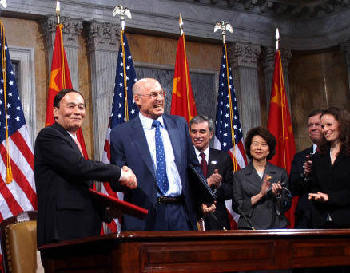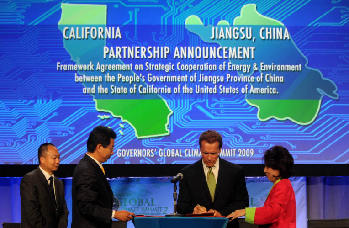China-U.S. Cooperation on Clean Energy and Environmental Protection Drives Sustainable Global Development
COOPERATION between China and the U.S. on clean energy and environmental protection is currently undergoing orderly progress under a new framework inaugurating a concerted model for addressing global climate change.
 |
| Then Chinese Vice Premier Wang Qishan and then U.S. Treasury Secretary Henry M. Paulson at the signing ceremony of the China-U.S. Ten Year Framework (TYF) for Cooperation on Energy and Environment in Washington, D.C. on June 18, 2008. |
The LP Amina Case
LP Amina is a North Carolina-based environmental engineering firm that provides proprietary solutions for emissions reduction in coal- and gas-fired power plants. It developed a technology that prevents larger coal-dust particles from entering boilers, so reducing NOx discharge by 15 percent, thereby significantly mitigating pollution from coal-fired power plants and also increasing employment in the manufacturing industry. The U.S.-China Clean Energy Research Center (CERC) was founded in 2011. After LP Amina participated in this initiative, a coal-dust separator featuring this technology was installed at Fengtai Power Plant in China’s Anhui Province. The positive results accruing soon induced the Chinese market to embrace this product, and LP Amina has since established a solid foothold in the country. CERC has also helped other transnational companies to succeed in the Chinese market.
Having almost reached the end of its first five-year term (2011-15), CERC has reaped a bounty of fruits from Sino-U.S. cooperation in R&D and production of clean coal, clean-energy motor vehicles and energy-efficient construction. In November 2014, Chinese President Xi Jinping and U.S. President Barack Obama jointly proclaimed their support for cooperation in CERC Phase II, agreeing to invest no less than US $2 billion from 2016 to 2020 to continue their support for core development via a governmental and enterprise investment vehicle, and to add “energy and water” as new fields of cooperation.
CERC is just one success story in the two countries’ collaboration on clean energy and environmental protection. Leaders of both countries see climate change as a strategic issue in bilateral ties, and have set in motion extensive and intensive cooperation in this regard. A complete system encompassing framework, mechanisms and actions is now taking shape in their cooperation on climate and environmental issues.
Framework and Mechanisms
Sino-U.S. collaboration on clean energy and environmental protection is operating under an authoritative and flexible framework and mechanisms.
In 2013, the U.S.-China Climate Change Working Group (CCWG) came into being to enhance policy dialogue and facilitate practical cooperative actions. The two nations reached agreement that year on implementation plans for the five initiatives launched under the CCWG, including emissions reduction from heavy-duty and other motor vehicles, smart grids, carbon capture, utilization and sequestration, collection and management of greenhouse gas data, and energy efficiency in buildings and industry.
The year 2014 saw the launch of three more initiatives: climate change and forestry, climate-smart/low-carbon cities, and industrial boiler efficiency and fuel conversion. The two sides reaffirmed the agreement reached by Xi Jinping and Obama in 2013 on hydrofluorocarbons (HFCs), pledging to take national action and promote bilateral cooperation to achieve meaningful progress in phasing out HFCs. They also agreed to collaborate through enhanced policy dialogue, including information-sharing, for their respective post-2020 plans to limit greenhouse gas emissions.
CCWG’s priority in 2015 is the global climate change talks in Paris. It plans to organize bilateral and international conferences to better the chances of clinching a deal at the Paris meeting.
During the 2008 U.S.-China Strategic Economic Dialogue (SED), the two countries signed the Ten-Year Framework (TYF) for Cooperation on Energy and Environment, which mobilizes different government agencies on both sides. The focuses of cooperation under this framework include electricity, water, air, transportation, wetlands, nature reserves and protected areas, and energy efficiency.
The “Sino-U.S. EcoPartnerships” is a platform under the TYF for the development of specific paired relationships between the two countries’ relevant local governments and agencies. This scheme encourages various local governments, enterprises, academic circles, institutes, administrative organs and training institutes, as well as other organizations, to voluntarily forge cooperative eco-partnerships. Via collaboration on special innovative projects, these local entities can share data and build capacity for test-runs of innovative policies and measures, develop, experiment on and promote innovative technologies. At the seventh round of the U.S.-China Strategic and Economic Dialogue (S&ED) in Washington, D.C. in June 2015, the U.S.-China joint secretariat announced six new eco-partnerships at a signing ceremony.
|
|
|
Jiangsu Province of China and the State of California of the U.S. sign the Framework Agreement on Strategic Cooperation of Energy and Environment on October 2, 2009. It is the first pact on new energy and emission reduction between local governments of the two countries. |
Bilateral and Global Significance
Climate change presents a grim challenge to humankind in the 21st century, and is manifested in the increasing frequency of extreme weather events such as droughts, floods and cyclones. Coping with this challenge will require concerted effort and worldwide action. As the world’s largest developing and developed countries, it behooves China and the U.S. to join hands in this mission in order to inspire more forceful global action. They set a good example in 2014 by issuing a joint communiqué on climate change that lent support to the Lima conference.
The Paris conference convening in December is expected to produce a new universal agreement on climate change for post-2020. Its outcome will determine whether humankind will reach the goal of limiting global warming to no more than 2°C – a failure here would unleash catastrophic consequences on the planet, and complicate the transition to green, sustainable development in the course of industrialization. It is also critical to constructing a model of global governance through the broadest ever collective consultation.
From this perspective, China and the U.S., as representatives respectively of the developing and developed world, must bolster their communication and coordination, adhere to the principles of common but differentiated responsibilities, equity and respective capabilities, and solidify their consensus to the utmost extent, while concerting their efforts to seek balanced, proportional results at the Paris conference.
The currently flagging global economy is primarily attributable to an aging population, the widening rich-poor divide, and regional economic bubbles, all of which result in a lack of effective demand in the real economy. Measures to ameliorate climate change, however, can generate this much-needed “creative demand.” Green growth in the U.S. has proven a boon for its economy, bestowing on it yet another competitive edge in the age of innovation. In China, the pressing problems of a slowing economy, severe pollution, and the urgent need for industrial upgrade and innovation all translate into a huge demand for green industries. Business opportunities abound in areas such as emissions reduction, efficient construction, and exploitation and use of clean energy, as well as remediation and protection of the eco-system. China and the U.S. can expand their cooperation in these areas in technology, management, marketing, financing and manufacturing; this will stimulate their domestic growth and industrial restructuring – in addition to that of the larger world – and thus usher in a new cycle of industrial revolution.
The Chinese and U.S. economies both heavily depend on fossil fuels such as coal, natural gas and oil, much of it imported. This poses a threat to their respective energy security. Each drastic change in human energy use leads to a revolution in global industry. As the cost of clean energy falls appreciably, thanks to technological advancements, world energy consumption is increasingly tilting towards the low-carbon end. Countries globally are looking to solar, wind, hydropower, biomass, oceanic, and nuclear sources for more energy supplies. Integration of advanced technologies such as distributed generation (DG) and smart grids in the power system have also wrought revolutionary changes on power supply and have hence shored up national energy security.
Earlier this year, the Obama administration announced more than US $4 billion in private sector commitments and executive actions to increase investment in clean energy innovation. It later unveiled the Clean Power Plan, an important step in reducing carbon pollution from power plants. These initiatives offer the potential for cooperation between the U.S., which boasts the world’s best technologies, and China, with the world’s largest market for technological applications. This will accordingly benefit both in their transition towards low-carbon development.
The new-model major-country relationship between China and the U.S. rests on the old basis of conventional security. Vulnerable to shifts in bilateral ties and the regional/international environment, it is thus inherently unstable. A solution to this problem is to expand bases and areas of cooperation to increase their strategic confluences. Climate change is opening up a new front and highlight in their collaboration. Since the inauguration of the S&ED in 2009, climate change, energy conservation and environmental protection have figured more prominently in their talks, and featured in half of the achievements reached at the seventh round of the S&ED. It is evident that practical cooperation between the two countries on climate, environment and clean energy has become another pillar of the new-model major country relationship between them.
Abundant scope exists for deepened and expanded cooperation between China and the U.S in clean energy and environmental protection, with a future focus on energy, the Internet and sustainable use of energy and water. With the merits of high workability, quick effects, tangible benefits and broad influence, this cooperation should indeed receive the attention from both sides it deserves.
- “We Must Grasp the Opportunity that Paris Offers”– Interview with Former President of the European Commission José Manuel Barroso
- Face History and Maintain Peace– Interview with Japan’s Former Prime Minister Tomiichi Murayama
- Building a New Relationship Model for China and the U.S.
- Upgraded Sino-European Relations Take Shape
- China Strives to Strengthen Global Infrastructure Construction and Build a Harmonious World

